SNU Museum of Art (MoA) Exhibits Historical Collections from Kobe
The moon is bright. The silhouette of people passing by the street of Saruwaka is lucid and the street vanishes from the picture towards its end. This is Nightview of Saruwaka Street (1856) by the most famous modern Japanese ukiyo-e artist UTAGAWA Hiroshige (1797-1858). The shadow was taken from the Western shading technique; the vanishing point from the West’s linear perspective. The world-famous Vincent van Gogh (1853-1890), infatuated with ukiyo-e (literally 'pictures of the floating world', the main artistic genre of Japanese woodblock painting), is assumed to have copied elements of subject matter and structure from this painting by Utagawa for his well known Cafe Terrace at Night (1888).
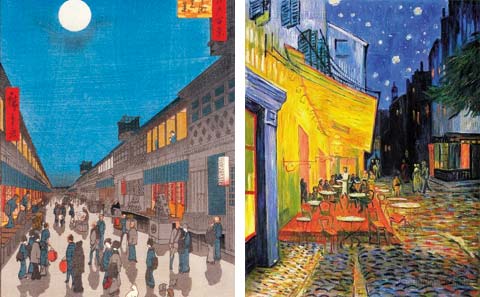
18th - 19th Century Japan through Her Paintings and Prints: Meeting with the West is on display from April 20 to June 5. Here you can see the Japanese reception of Western culture, as seen in Utagawa’s painting, demonstrated through various visual representations. The exhibition provides an opportunity to understand that the era of liberalism which prevailed in the Edo period was partly due to the early modernization of perspective from incoming Western culture.
The show claims to be an addition to efforts to shed new light on Western influence in East Asia. The fact that Japan opened her borders and maintained a relationship with the West―that is the Netherlands―since an early period also adds weight to the exhibition’s role of studying the influences of cultures and of showing how contemporary Japanese society is a result of an amalgam of those influences.
MoA Director CHUNG Hyung-Min commented in her opening speech that she learned a lot from the Director of the Kobe City Museum who “hung the paintings one by one with his own hands” and “treated [the paintings] as though they were newborn babies.” With this special exhibition having gone through painstaking preparations, MoA now invites all members of the SNU community as well as all others with interest in this exhibition to visit.
The Opening of Modern Japan
Before the modern Meiji era (1686-1912) there had already been two opportunities from which Japan encountered Western paintings. The first occurred in 1549 when the Jesuit missionary Francisco de Xavier (1506-1552) came to Japan, giving rise to Namman (literally 'southern barbarians') culture which affected Japanese paintings with a strong Christian tone. Compared to Namman culture, which quickly and almost completely disappeared due to the oppressive samurai regime emerging soon afterwards, the second influx of Western culture during the Edo period was very influential in that it survived to form an essential part of Japanese modern culture, and established itself as one of the dominant schools of art in the Edo period. This exhibition shows this process of the infusion of Western culture into Japan during the Edo period, and thus is composed of five parts following history's chronological order. The first section,"Nagasaki Trade During the Edo Period", illustrates the atmosphere of Nagasaki at the time, which was the one and only passageway through which foreigners encountered Japan.
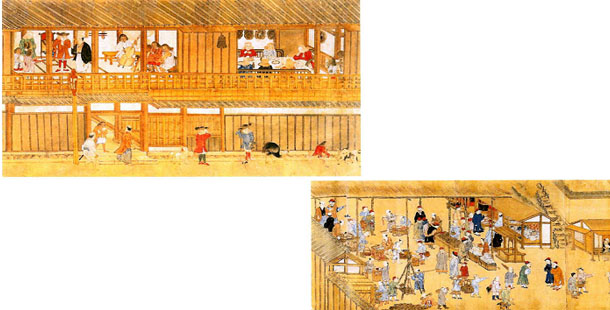
Settlements in Nagasaki
From these paintings one can almost imagine how active the exchange and intermingling of cultures must have been, which ultimately led to a consolidated Meiji era in modern Japan.
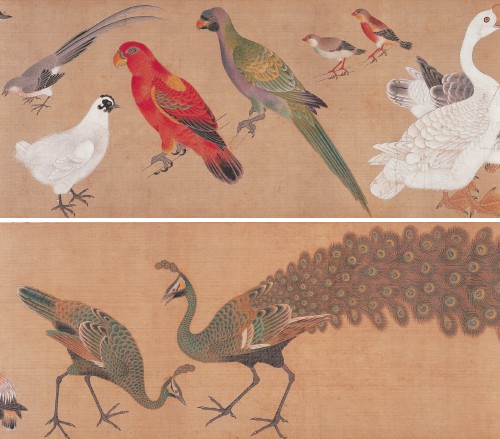
Paintings of valuable birds that came across the wide ocean, such as the ones shown above, effectively communicate what trade between the Dutch and the Bakufu was like.
Two Tidal Waves: Chinese and Western Influences
The following two sections titled “A New Gust of Air from China: The Popularity of CHEN Nan-Pin’s Style of Painting” and “Prints and Western-Style Paintings from the Netherlands” focus on the actual source of the change that occurred in Japanese paintings―culture from abroad. Professor LEE Jung Hi at KeiMyung University Department of Art wrote in his essay that the school of Western-style painting during the Edo period, which emerged as a result of these two new tidal waves of influence, “is characteristic for its resolute denial of the methods of Eastern conceptual paintings.”
This may be subject to controversial debate as blind reception of another’s culture into one’s own is usually looked down upon or even chastised with the argument that the previously existing identity, as valuable as it is, can be lost. But do not be too critical yet. According to Professor Lee, the technique of painting called ‘detailed realism’ is uniquely Japan’s. The interest in practical science in relation to detailed and realist paintings arose autogenously from Japan’s botanic research which flourished due to the Bafuku’s policy of preventing an outflow of gold and silver to China. From China Japan was importing massive quantities of medicinal herb supplies. This is why foreign influence was indeed well-received by the Japanese and almost completely took the place of the Japanese traditional style of painting. As Professor Lee put it into words, “the reason why Western influence was so readily absorbed into Japanese paintings was not because the wave of Western colonialism was so great but because they needed it.”
As is evident from its title, the second section of the exhibition presents CHEN Nanpin’s paintings which were highly popular after the Bafuku’s General Yoshimune relaxed the ban on Western paintings and literature. Chen Nanpin (1682-1760?) was a Chinese painter who was invited to Nagasaki in 1731. He employed a realist style painting technique through minute portrayals and sharp colors.
The second wave of influence from across the ocean which permanently affected Japanese paintings is demonstrated in the next section of the exhibition. “Prints and Western-Style Paintings from the Netherlands” includes Dutch prints which were the subject of research and translated by Japanese intellectuals and other books on various subjects based on Western prints such as the arts, medical sciences, and natural sciences. The first original edition of Kaitaishinshyo, the first complete translated book ever in Japan published in 1774, is perhaps the most significant artifact on display. This book is acclaimed as the prelude to the rise of Western medicine in Japan. Various pictographs in this book as well as other prints came to the Japanese as an enlightening shock, ultimately leading to the Japanese application of those pictures in their paintings―some of which are also displayed in this section.
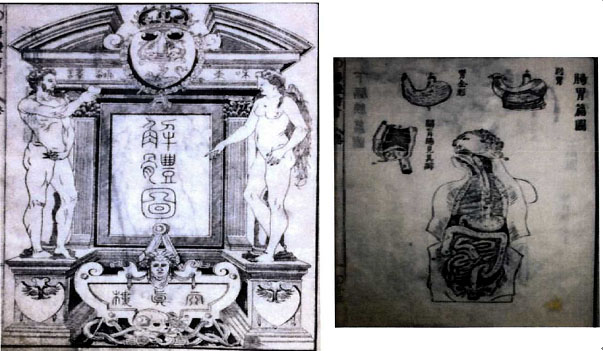
This book was the first complete translation of a Western book and also the first anatomy book translated into Japanese.
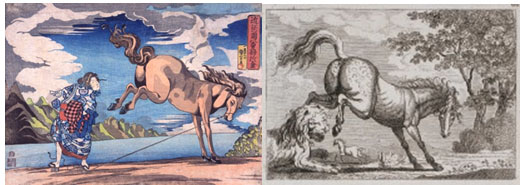
This scene is drawn from consulting the etching work on the right from France. The emphasis on shadow effect demonstrates the Western influence while the transformation of the lion into a woman is in traditional Japanese style. (On the right) Horse and the Lion from Aesop’s Fables, 1810.
Realistic and Three Dimensional Paintings after Encountering the West
A lmost certainly the zenith of this exhibition lies towards the end of your walk through the exhibition.
“Three Western-Style Japanese Painters of the Edo Period” features three Japanese painters who embraced European studies, techniques, and culture and incorporated them into their paintings -- SHIBA Kokan (1747-1818), AODO Denzen (1748-1822), and YASUDA Raishu (unknown) -- as the popularity of Western realist techniques reached Edo all the way from a small village, Akita, located in Northeastern Japan.
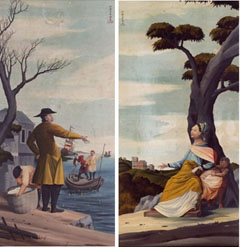
Shiba Kokan, a principal figure of Japanese-style Western paintings, drew these two paintings with reference to Occupation of Humans published in the Netherlands. Here he demonstrates his unique way of painting through oriental-like expression of figures and big trees in the background while setting the scene in a European location and the figures in Occidental poses. The exhibition keeps the best for last. “Uki-e and Megane-e” are two genres said to be representative of modern Japanese perspective. Uki-e, literally translated as ‘floating picture’, is a genre of painting drawn by employing the linear perspective, and of anything new and attracting curiosity expressed realistically for the common crowd’s knowledge. Megane-e is a type of picture used on a mechanism called boit d’optique which makes objects appear three-dimensional and hence look real. Peering through the hole of the box which was moved entirely to the museum, one can imagine how it would have been received with great interest perhaps not unlike how IMAX movies are looked upon today.
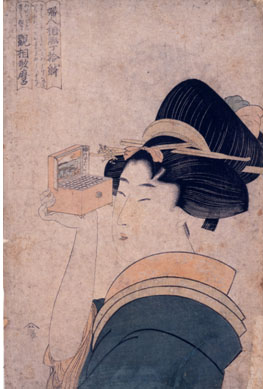
The miniature peepshow box, which the cute woman in the picture is peering into, is an example of megane-e that was widely popular around 1976 in Japan among the upper class. The picture drawn on a flat surface is three-dimensionalized through a convex lens built into a box, as can be seen above.
Some Useful Information
The Opening Ceremony for this Special Exhibition was held on April 20 at 5pm. On this day, SNU Vice-President PARK Myung-Jin, Kobe City Museum Director KAJIMOTO Hideo, who was courteous enough to lend its collections, the Director of the Japan Foundation Seoul Center HONDA Osamu, who sponsored the show, and finally the Director of SNU MoA CHUNG Hyung-Min, who planned this grand event, gave greetings and gratitude which resonated through the Lecture Hall. The exhibition was met with due spotlights, attracting many reporters to a press conference held on the day of the exhibition opening.
This special exhibition will be held from April 20 to June 5, 2011. Originally scheduled to close on May 29, MoA decided to prolong the exhibition due to its immense popularity. The exhibition displays up to 80 valuable cultural properties from the collections of Kobe City Museum.
The exhibition will be accompanied by ‘docents’―SNU students who will be ushering the exhibition as a community service, and by Oka Yasumasa, a researcher of the Kobe City Museum, who will give a special lecture titled “Discovery of Depth―Contact and Acculturation of Japanese Paintings with Western Art in the 18-19th Century” on Thursday, April 21 in the Lecture Hall (2nd floor, MoA) at 4:30p.m.
As an extension of the Academic Forum held between Korea, Japan, and China earlier this year on the subject of Western influence on Eastern paintings, the show was designed to further understanding of Japanese culture through displaying not only art works but also prints from the earliest times when Asia met the West. Oh JinYee, the MoA arts and science researcher who was in charge of planning this exhibition, remarked that “the exhibition shows how paintings are not only influenced by paintings themselves but by the course of history.” For inquiries you may contact 02-880-9508.
Written by LEE BoYoung, SNU English Editor bylee0708@gmail.com ?
Reviewed by Eli Park Sorensen, SNU Professor of Liberal Studies
Proofread by Brett Johnson, SNU English Editor

